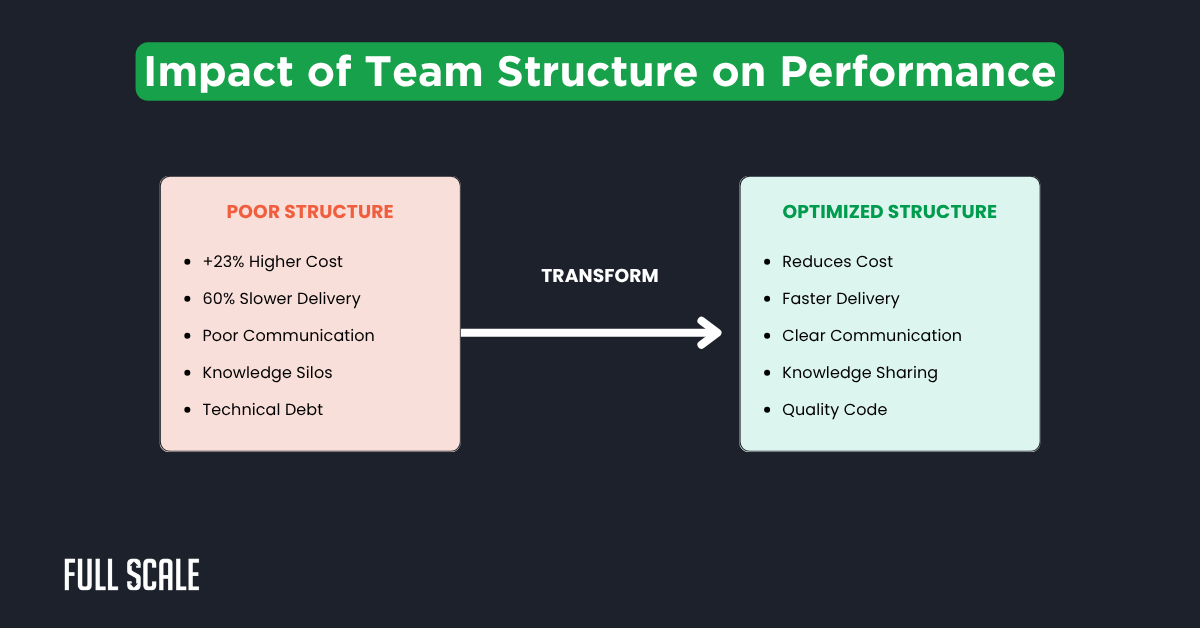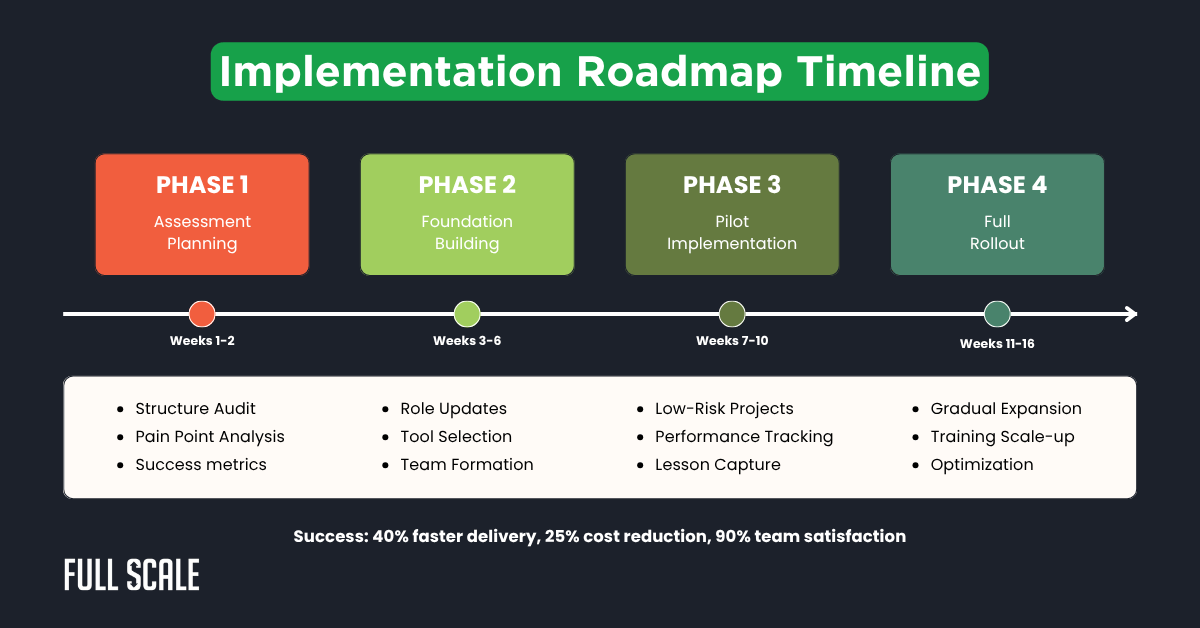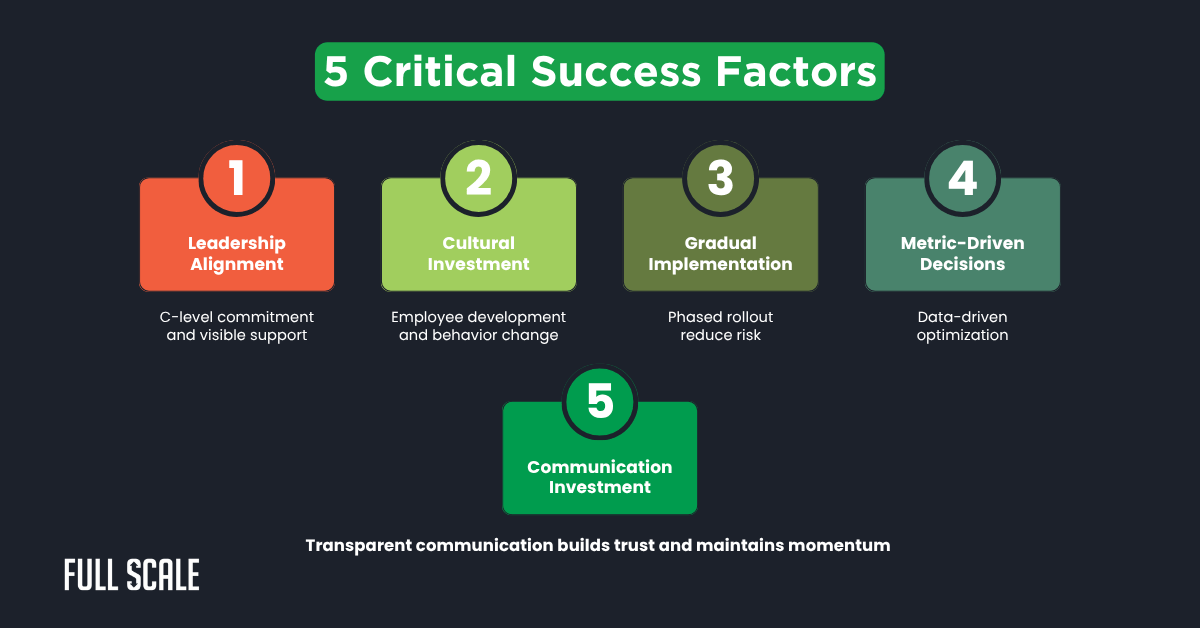Last Updated on 2025-06-23
Poor team structures cost companies 23% more in project expenses. They deliver features 60% slower than optimized teams. This data comes from a 2024 DevOps Research and Assessment (DORA) report. McKinsey’s 2024 Developer Velocity Index reveals additional insights. Organizations with well-structured development teams are 4.5 times more likely to be top performers.
Key Benefits of Optimized Software Development Team Structures:
- Reduce project costs by up to 23% through improved coordination and resource allocation
- Accelerate feature delivery by 60% with streamlined communication and clear accountability
- Increase developer satisfaction, leading to better retention and higher code quality
- Scale effectively as organizations grow from a startup to an enterprise level
- Align technical architecture with team communication patterns for sustainable systems
The right software development team structures determine project success, developer satisfaction, and business growth. This comprehensive guide reveals proven frameworks for selecting optimal team models, which support long-term technical success and organizational growth.

The Hidden Cost of Wrong Team Structure
Software development team structures directly impact architectural decisions through predictable patterns. Poor team organization compounds into technical debt, delayed deliveries, and escalating operational costs. The relationship between team structure and software architecture creates lasting consequences. System maintainability suffers when teams lack proper organization.
The CTO’s Nightmare: Scaling Without Structure
Knowledge silos emerge when developers become single points of failure. This happens frequently in poorly organized teams. Technical debt accumulates faster due to inconsistent practices across disconnected groups. Cross-team dependencies create productivity bottlenecks that delay feature releases.
Code quality degrades when the software development team structures don’t support proper review processes. When key team members leave, organizations lose months of domain expertise. This creates significant risk and slows down onboarding for replacement developers. Understanding software development team roles and responsibilities becomes critical for preventing these issues.
The Product Manager’s Dilemma: Speed vs. Quality
Feature delivery delays plague teams with unclear handoff processes. These delays occur between different development stages. Roadmap bottlenecks develop when features get stuck without clear progression paths. Stakeholder communication becomes chaotic when multiple teams work on interconnected features.
Product managers struggle to provide accurate delivery timelines. They lack visibility into team capacity and workflow patterns. Managing expectations becomes difficult across team silos with competing priorities.
The CFO’s Financial Reality: Hidden Costs
Resource inefficiency occurs when teams have unbalanced skill distributions. Senior developers performing junior tasks represent significant underutilization of expensive talent. Budget overruns become common when teams lack clear accountability structures. ROI uncertainty increases when organizations cannot determine which development team models deliver value.
Cost optimization becomes impossible without understanding team effectiveness patterns. Performance metrics help identify the best software development team structure for startups and growing organizations.
The HR Director’s Talent Challenge
Recruitment confusion arises when hiring managers cannot specify the needed developer types. Career path ambiguity creates dissatisfaction among developers seeking professional growth opportunities. Team structure directly impacts job satisfaction and long-term employee retention rates. Onboarding complexity increases when new hires navigate unclear team structures.
Poor organization makes talent acquisition and development significantly more challenging. This affects growing organizations and established enterprises equally.
The FullScale Framework for Team Structure Selection
The SCALE framework provides systematic criteria for evaluating appropriate software development team structures. This decision-making tool considers organizational context, technical requirements, and business constraints. Each factor influences optimal team model selection for specific situations.

Each factor influences optimal team model selection:
S – Size and Stage: Startup organizations (5-20 developers) need flexible structures supporting rapid iteration. The best software development team structure for startups typically emphasizes autonomy and cross-functional capabilities. Growth-stage companies (20-100 developers) require transition strategies. They must maintain agility while adding necessary processes. Enterprise organizations (100+ developers) need complex coordination mechanisms and clear hierarchies.
C – Complexity: Single products allow focused team structures. Multi-product portfolios require coordination mechanisms between different development streams. Monolithic architectures support different team patterns than microservices architectures. Technical complexity assessment determines specialization levels and coordination requirements.
A – Agility Requirements: Time-to-market pressures favor autonomous team structures. These structures minimize coordination overhead and enable rapid decision-making. Regulatory requirements in fintech and healthcare demand compliance-focused team organization. Innovation versus stability balance influences team autonomy levels.
L – Location and Distribution: Co-located teams enable different collaboration patterns than distributed teams. Remote-first organizations require asynchronous communication structures and cultural alignment strategies. Hybrid and offshore development team structure models need specialized coordination approaches. These approaches bridge geographic and cultural differences effectively.
E – Expertise and Skills: Available talent pool constraints influence team composition and structure options. Specialized skill requirements may necessitate component-based or matrix team models. Learning and development needs affect team stability and knowledge transfer requirements.
Complete Guide to Software Development Team Models
Seven primary team models address different organizational needs and technical constraints. Each model offers distinct advantages for scalability, delivery speed, code quality, and cost optimization. Understanding these models enables strategic decisions about team organization.
1. Traditional Hierarchical Teams
Traditional hierarchical teams feature clear chains of command and specialized role responsibilities. This structure works best for large enterprises with complex compliance requirements. Well-defined project specifications benefit from this organizational approach.
Best For:
- Enterprise organizations with strict governance requirements
- Projects requiring detailed documentation and approval processes
- Teams needing clear accountability and career progression paths
Advantages:
- Clear accountability and predictable career progression
- Efficient coordination for large, complex projects
- Strong governance and compliance capabilities
Disadvantages:
- Slow decision-making and reduced adaptability
- Innovation bottlenecks through approval layers
- Limited cross-functional collaboration opportunities
2. Cross-Functional Agile Teams
Cross-functional agile teams organize around self-contained units with comprehensive skill sets. Sprint-based delivery cycles enable rapid iteration and continuous feedback incorporation. This agile team structure suits product development companies with evolving requirements.
Best For:
- Product development companies with changing requirements
- Organizations prioritizing rapid delivery and customer feedback
- Innovation-focused companies require team autonomy
Advantages:
- Fast delivery cycles and high adaptability
- Strong team ownership and feature accountability
- Reduced handoff delays and communication overhead
Disadvantages:
- Requires significant cultural change and management training
- Coordination challenges when scaling beyond single teams
- Potential for inconsistent practices across multiple teams
3. Squad-Based Model (Spotify Model)
Squad-based models feature small autonomous teams with minimal external dependencies. Tribes provide coordination for related squads while chapters and guilds maintain consistency. This approach benefits fast-growing technology companies with multiple product areas.
Best For:
- Fast-growing tech companies with clear product domains
- Organizations prioritizing innovation and cultural scaling
- Companies with autonomous product development needs
Advantages:
- High team autonomy and innovation potential
- Excellent scalability for company culture
- Flexible resource allocation across initiatives
Disadvantages:
- Coordination complexity increases with organizational scale
- Potential for inconsistent standards and technical practices
- Requires a strong cultural foundation and experienced leadership
4. Feature-Based Teams
Feature-based teams organize around specific product features or user journey segments. Temporary team formation enables focused development on particular initiatives. This model works well for companies with clear user journey mapping.
Best For:
- Product companies with distinct user journeys
- Time-boxed feature development projects
- Organizations with rotating project priorities
Advantages:
- Clear feature ownership and end-to-end accountability
- Flexible resource allocation based on changing priorities
- Reduced cross-team dependencies for feature delivery
Disadvantages:
- Knowledge transfer challenges when teams dissolve
- Potential skill gaps when forming new teams
- Difficulty maintaining long-term architectural vision
5. Component-Based Teams
Component-based teams organize around technical architecture components and system boundaries. This model suits complex technical products with clear component separation. Microservices team organization benefits significantly from this approach.
Best For:
- Complex technical products with component separation
- Microservices architectures require specialized expertise
- Organizations needing deep technical specialization
Advantages:
- Deep technical expertise and architectural ownership
- Independent development and deployment capabilities
- Strong code quality through focused specialization
Disadvantages:
- Feature delivery coordination requires cross-team collaboration
- Potential for local optimization over system-wide benefits
- Risk of architectural silos and accumulated technical debt
6. Matrix Teams
Matrix teams feature dual reporting relationships between functional and project management. This model works best for consulting organizations. Companies managing multiple concurrent projects with shared resources also benefit.
Best For:
- Consulting and professional services organizations
- Companies managing multiple concurrent projects
- Organizations requiring flexible resource utilization
Advantages:
- Flexible resource utilization across projects
- Knowledge sharing and skill development opportunities
- Efficient use of specialized expertise
Disadvantages:
- Unclear accountability and potential conflicting priorities
- Complex management overhead and communication requirements
- Difficulty maintaining team cohesion and shared culture
7. Distributed/Remote Teams
Distributed teams organize across geographic locations with asynchronous communication emphasis. This model benefits organizations seeking global talent access. Cost optimization through geographic distribution becomes a key advantage. Remote development team structure best practices include clear communication protocols and cultural integration strategies.
Best For:
- Organizations seeking global talent access
- Companies requiring cost optimization strategies
- Teams with an established remote work culture
Advantages:
- Access to a global talent pool and specialized skills
- Cost-effective scaling through geographic arbitrage
- 24/7 development potential through timezone coordination
Disadvantages:
- Communication challenges across different time zones
- Cultural alignment difficulties and relationship building
- Increased technology infrastructure and security requirements
DevOps Team Structure Integration
Modern software development team structures increasingly incorporate DevOps practices. DevOps team structure can be implemented across multiple models. Cross-functional agile teams naturally integrate development and operations responsibilities. Component-based teams can specialize in specific infrastructure domains.
The key is ensuring deployment, monitoring, and infrastructure management capabilities exist within chosen structures. This integration accelerates delivery cycles and improves system reliability.
Team Structure Comparison Matrix
This comparison helps organizations evaluate team models across key performance criteria. Consider multiple factors when making final structure decisions.
| Model | Scalability | Speed | Quality | Cost | Best Use Case |
| Hierarchical | High | Low | High | High | Enterprise |
| Agile | Medium | High | Medium | Medium | Product Development |
| Squad-Based | High | High | Medium | Medium | Fast Growth |
| Feature-Based | Medium | High | Medium | Low | Feature-Rich Products |
| Component-Based | Medium | Medium | High | High | Complex Architecture |
| Matrix | High | Medium | Medium | Medium | Multi-Project |
| Distributed | High | Medium | Medium | Low | Global Talent |
Implementation Roadmap: From Planning to Execution
Successful transformation requires systematic planning and phased execution. This approach minimizes disruption to ongoing projects. This roadmap provides a structured approach for implementing new software development team structures.

Phase 1: Assessment and Planning (Weeks 1-2)
Current State Analysis:
- Complete team structure audit using performance metrics
- Conduct stakeholder interviews across all affected roles
- Perform skills inventory and gap analysis
- Map current pain points to structural root causes
Future State Design:
- Apply the SCALE framework for structure selection
- Develop a transition timeline with clear milestones
- Create risk mitigation plans for identified challenges
- Define success metrics and measurement approaches
Phase 2: Foundation Building (Weeks 3-6)
Organizational Changes:
- Update role definitions and reporting structures
- Establish new communication protocols and decision-making processes
- Evaluate and select the necessary tool stack changes
- Prepare documentation systems for knowledge sharing
Team Formation:
- Design team composition strategies for balanced skills
- Assign leadership roles and responsibilities
- Plan cultural integration and change management
- Develop training programs for new processes
This phase focuses on defining software development team roles and responsibilities clearly. Documentation ensures everyone understands their position within the new structure.
Phase 3: Pilot Implementation (Weeks 7-10)
Pilot Execution:
- Select low-risk projects with motivated participants
- Form initial teams using new organizational principles
- Document processes and capture lessons learned
- Monitor performance and gather continuous feedback
Optimization:
- Conduct weekly retrospectives for rapid issue identification
- Track performance metrics against baseline measurements
- Adjust processes based on real-world experience
- Communicate progress to stakeholders regularly
Phase 4: Full Rollout (Weeks 11-16)
Gradual Expansion:
- Apply lessons learned from the pilot implementation
- Execute phased team transitions, minimizing disruption
- Scale training and support systems organization-wide
- Implement performance optimization based on data
Real-World Case Studies and Success Stories
These examples demonstrate successful software development team structure transformations across different industries. Each case provides specific challenges, solutions, and measurable outcomes. The results show how strategic team organization delivers competitive advantages through improved efficiency and developer satisfaction.
FinTech Startup: Hybrid Squad Model Success
A rapidly growing financial technology company scaled from 10 to 50 developers. They maintained regulatory compliance throughout this growth period. They implemented hybrid squad-based software development team structures with specialized security teams.
Results:
- 40% faster feature delivery through autonomous operation
- Zero security incidents over 12 months
- 90% developer satisfaction in quarterly surveys
- 25% technical debt reduction through integrated practices
Key Lesson: Specialized expertise remains necessary even in autonomous team structures. Regulated industries requiring governance oversight benefit from hybrid approaches.
E-commerce Platform: Component-Based Transformation
An established e-commerce company with 200+ developers adopted component-based teams. These teams aligned with technical architecture boundaries. This addressed duplicate development efforts across product lines.
Results:
- 60% improvement in cross-product feature delivery
- 35% reduction in duplicate code development
- 50% faster onboarding for new developers
- 20% cost reduction through optimized resource allocation
Key Lesson: Architectural alignment with team structure reduces coordination overhead. This approach improves development efficiency across complex systems.
Healthcare Technology: Global Distribution Success
A healthcare software company coordinated development across four time zones. They met strict compliance requirements throughout this process. They implemented distributed agile teams with overlapping hours and specialized compliance roles.
Results:
- 24/7 development cycle establishment
- 30% cost reduction through global talent access
- 100% compliance audit success rate
- 45% improvement in time-to-market
Key Lesson: Cultural bridge-building investments enable effective distributed team coordination. This approach maintains quality standards and regulatory compliance.
Key Success Factors for Team Structure Transformation
Analysis of successful implementations reveals critical factors determining transformation success. These patterns consistently appear across industries and organizational sizes. Understanding these factors improves implementation outcomes significantly.

Five critical factors consistently determine implementation success:
- Leadership Alignment: C-level commitment and visible support throughout the change process
- Cultural Investment: Team structure changes supported by corresponding cultural development
- Gradual Implementation: Phased approaches reduce risk and increase adoption rates
- Metrics-Driven Decisions: Data-driven optimization leads to sustainable improvements
- Communication Investment: Transparent communication builds trust and maintains momentum
Your Path to Optimal Software Development Team Structures
Choosing the right software development team structures creates environments where developers thrive. These environments enable businesses to grow sustainably and compete effectively. Whether addressing scaling challenges, delivery delays, or cost concerns, these frameworks provide actionable roadmaps.
Key takeaways for implementation success:
- No universal solution exists – The best structure aligns with your specific organizational context and technical requirements
- Use systematic evaluation – Apply the SCALE framework to make informed decisions based on objective criteria
- Start with pilot programs – Reduce risk through gradual implementation and learning from small-scale experiments
- Measure and optimize continuously – Data-driven adjustments ensure teams improve over time and adapt to changing needs
- Invest in cultural change – Technical restructuring requires corresponding changes in communication and collaboration patterns
Your transformation journey begins with a systematic assessment and stakeholder alignment. Complete the team structure evaluation using the provided frameworks. Then select appropriate models for your organizational context and growth objectives.
Need Expert Help? Let’s Talk
Full Scale provides dedicated software development teams that integrate seamlessly with your chosen team structure. Our experience across multiple team models and industries enables successful implementation. We reduce risk while accelerating results for growing organizations.
When to Consider Professional Guidance:
- Complex multi-location implementations requiring cultural integration
- Regulatory compliance requirements in fintech, healthcare, or other industries
- Large-scale transformations involving 100+ developers
- Tight timeline constraints requiring experienced implementation support
What Full Scale Can Help With:
- Dedicated development teams integrating with your existing structure
- Proven experience with all software development team structures covered in this guide
- Specialized expertise in fintech, healthcare, and e-commerce industries
- Flexible scaling options matching your growth trajectory
Ready to Optimize Your Team Structure?
Our team of structure experts has helped 200+ companies optimize their development organizations. We can help you choose the right model, implement it successfully, and scale as you grow.
Get Your Free Team Structure Assessment
FAQs: Software Development Team Structures
What are the most effective software development team structures for different company sizes?
The best software development team structure depends on your organization’s size and stage:
- Startups (5-20 developers): Cross-functional agile teams work best for rapid iteration and flexibility
- Growth companies (20-100 developers): Squad-based models like Spotify’s approach enable scaling while maintaining autonomy
- Enterprise (100+ developers): Hybrid approaches combining hierarchical oversight with agile execution provide necessary governance
Component-based teams suit complex technical products, while feature-based teams work well for companies with distinct user journeys.
How do you choose between agile team structure and traditional hierarchical models?
Choose agile team structures when you need rapid delivery and frequent requirement changes. Select hierarchical models for complex compliance requirements and well-defined projects.
Key decision factors include:
- Speed requirements – Agile delivers faster, hierarchical provides more control
- Regulatory needs – Fintech and healthcare often require hierarchical governance
- Team experience – Agile requires cultural maturity and self-organization skills
- Project complexity – Simple products favor agile, complex enterprise systems may need hierarchy
Most organizations benefit from hybrid approaches that combine both structures strategically.
What are the essential software development team roles and responsibilities in modern teams?
Modern software development teams require these core roles regardless of structure:
- Product Owner: Defines requirements, prioritizes features, manages stakeholder communication
- Scrum Master/Team Lead: Facilitates processes, removes blockers, ensures team productivity
- Developers: Write code, participate in reviews, contribute to architecture decisions
- DevOps Engineer: Manages deployment pipelines, infrastructure, and monitoring systems
- QA Engineer: Designs test strategies, ensures quality standards, automates testing
Cross-functional development team structures often combine these roles, with team members wearing multiple hats based on project needs and expertise.
How does offshore development team structure differ from in-house teams?
Offshore development team structures require additional coordination and communication layers:
Key differences:
- Communication protocols – Structured handoffs, documented processes, overlap hours for real-time collaboration
- Cultural integration – Bridge-building programs, shared values establishment, regular team building
- Management approach – Results-focused rather than activity-focused, clear deliverable definitions
- Tool requirements – Enhanced project management, communication platforms, code collaboration tools
Remote development team structure best practices include establishing clear workflows, regular check-ins, and cultural alignment strategies to maintain team cohesion across geographic boundaries.
How can FullScale help implement the right software development team structures?
FullScale provides dedicated development teams that integrate seamlessly with your chosen team structure approach:
Our services include:
- Team structure assessment – Evaluate your current setup using proven frameworks
- Dedicated team integration – Provide skilled developers who fit your organizational model
- Scalable team architecture – Flexible scaling options that match your growth trajectory
- Industry expertise – Specialized knowledge in fintech, healthcare, and e-commerce team structures
We help you implement software development team structures that reduce costs, accelerate delivery, and maintain quality standards while providing the flexibility to adapt as your organization evolves.

Matt Watson is a serial tech entrepreneur who has started four companies and had a nine-figure exit. He was the founder and CTO of VinSolutions, the #1 CRM software used in today’s automotive industry. He has over twenty years of experience working as a tech CTO and building cutting-edge SaaS solutions.
As the CEO of Full Scale, he has helped over 100 tech companies build their software services and development teams. Full Scale specializes in helping tech companies grow by augmenting their in-house teams with software development talent from the Philippines.
Matt hosts Startup Hustle, a top podcast about entrepreneurship with over 6 million downloads. He has a wealth of knowledge about startups and business from his personal experience and from interviewing hundreds of other entrepreneurs.




